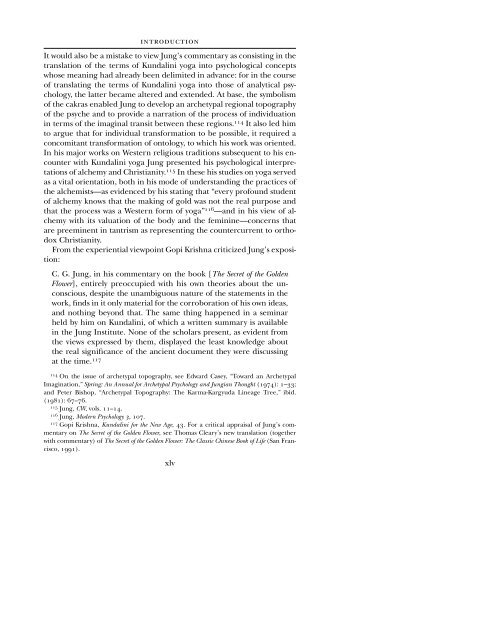CG JUNG - Countryside Anarchist
CG JUNG - Countryside Anarchist
CG JUNG - Countryside Anarchist
You also want an ePaper? Increase the reach of your titles
YUMPU automatically turns print PDFs into web optimized ePapers that Google loves.
INTRODUCTION<br />
It would also be a mistake to view Jung’s commentary as consisting in the<br />
translation of the terms of Kundalini yoga into psychological concepts<br />
whose meaning had already been delimited in advance: for in the course<br />
of translating the terms of Kundalini yoga into those of analytical psychology,<br />
the latter became altered and extended. At base, the symbolism<br />
of the cakras enabled Jung to develop an archetypal regional topography<br />
of the psyche and to provide a narration of the process of individuation<br />
in terms of the imaginal transit between these regions. 114 It also led him<br />
to argue that for individual transformation to be possible, it required a<br />
concomitant transformation of ontology, to which his work was oriented.<br />
In his major works on Western religious traditions subsequent to his encounter<br />
with Kundalini yoga Jung presented his psychological interpretations<br />
of alchemy and Christianity. 115 In these his studies on yoga served<br />
as a vital orientation, both in his mode of understanding the practices of<br />
the alchemists—as evidenced by his stating that “every profound student<br />
of alchemy knows that the making of gold was not the real purpose and<br />
that the process was a Western form of yoga” 116 —and in his view of alchemy<br />
with its valuation of the body and the feminine—concerns that<br />
are preeminent in tantrism as representing the countercurrent to orthodox<br />
Christianity.<br />
From the experiential viewpoint Gopi Krishna criticized Jung’s exposition:<br />
C. G. Jung, in his commentary on the book [The Secret of the Golden<br />
Flower], entirely preoccupied with his own theories about the unconscious,<br />
despite the unambiguous nature of the statements in the<br />
work, finds in it only material for the corroboration of his own ideas,<br />
and nothing beyond that. The same thing happened in a seminar<br />
held by him on Kundalini, of which a written summary is available<br />
in the Jung Institute. None of the scholars present, as evident from<br />
the views expressed by them, displayed the least knowledge about<br />
the real significance of the ancient document they were discussing<br />
at the time. 117<br />
114 On the issue of archetypal topography, see Edward Casey, “Toward an Archetypal<br />
Imagination,” Spring: An Annual for Archetypal Psychology and Jungian Thought (1974): 1–33;<br />
and Peter Bishop, “Archetypal Topography: The Karma-Kargyuda Lineage Tree,” ibid.<br />
(1981): 67–76.<br />
115 Jung, CW, vols. 11–14.<br />
116 Jung, Modern Psychology 3, 107.<br />
117 Gopi Krishna, Kundalini for the New Age, 43. For a critical appraisal of Jung’s commentary<br />
on The Secret of the Golden Flower, see Thomas Cleary’s new translation (together<br />
with commentary) of The Secret of the Golden Flower: The Classic Chinese Book of Life (San Francisco,<br />
1991).<br />
xlv


